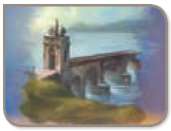
Trajan (born Marcus Ulpius Trajanus) has gone down in history as the best Roman Princeps (Optimus Princeps). He was the first Emperor of Rome who came not from the city but from a province.
During his reign (98 to 117 AD), the Roman Empire reached its largest extent. And Trajan undertook numerous building projects and social operations. Among other things, he established several cities (Coloniae); and with the construction of the Forum Trajanum, he erected a monument during his lifetime to serve as his memorial that has (partially) survived to this day.
The Forum of Trajan is the biggest and, to this day, best preserved of the so-called Emperor's forums in Rome that were erected by Caesar, Augustus, Nerva, and Trajan to supplement the Forum Romanum.
A forum was needed for tasks in government and administration, but also served as a city square and market place. In order to have the Forum Trajanum (or Forum Traiani) built, Trajan first ordered the removal of an approximately 35-meter-high hill.
Prominent elements of the Forum of Trajan were the Trajan Markets, the Basilica Ulpia, two libraries, and the Trajan's Column. Trajan's successor, Hadrian, is said to have had a temple added in honor of Trajan.
The Trajan Markets consisted of multi-story semicircular buildings with shopping streets that were partially roofed, so that customers could go shopping and stay dry even when it was raining. The upper stories probably served administrative purposes. Some researchers consider the Trajan Markets the oldest shopping mall in the world.
The Basilica Ulpia, with its impressive portico, probably housed offices, e.g., for justice and trade. The Basilica Ulpia was not used for religious purposes. Two centuries later, however, it served Emperor Constantine as an inspiration for the construction of Christian churches and the Basilica of Maxentius.
The Library, consisting of two buildings, kept Latin books in one of them and Greek books in the other.
The Trajan's Column, still preserved to date, is located between the library buildings. It is a triumphal column commemorating Trajan's merits in the victory over the Dacians and the integration of Dacia as a Roman province.
The relief of the column depicts scenes from the wars against the Dacians. Instead of Trajan, a statue of the apostle Peter has been standing on top of the column since the Middle Ages. The height of the Trajan's Column is said to have matched the height of the hill that was removed for the construction of the Forum of Trajan.
Originally, a Colonia was a settlement built within the Roman Empire but outside of Rome that served to secure newly conquered provinces. In these settlements or cities, usually systematically arranged like a chessboard, there lived a part of the original population as well as newly settled Romans who became landowners this way.
The Colonia Ulpia Traiana (nowadays, Xanten, Germany), for example, was one of about 150 cities that had major municipal rights in the Roman Empire. Even though the modern term "colony" is derived from the word "Colonia", the Coloniae are not to be confused with the Roman provinces.

For more than a thousand years, the Trajan's Bridge across the Danube, constructed during the wars against the Dacians and 1135 m long, was the longest bridge built by humans.
As evidence of this achievement, the Tabula Traiana, a large carved block of stone, can still be found at the banks of the Danube in present-day Serbia.

The Tropaeum Traiani, built in 109 AD in present-day Romania, commemorates Trajan's victories over the Dacians. The term "Tropaeum" is derived from the ancient Greek word "Tropaion", which can be traced back to the meaning of "to flee" or "flight".
It refers also to the wooden "military scarecrows" that - decorated with weapons and armor - were positioned at that place on the battlefield where the enemy had taken flight and thus the Romans had achieved victory.
Continue Reading

